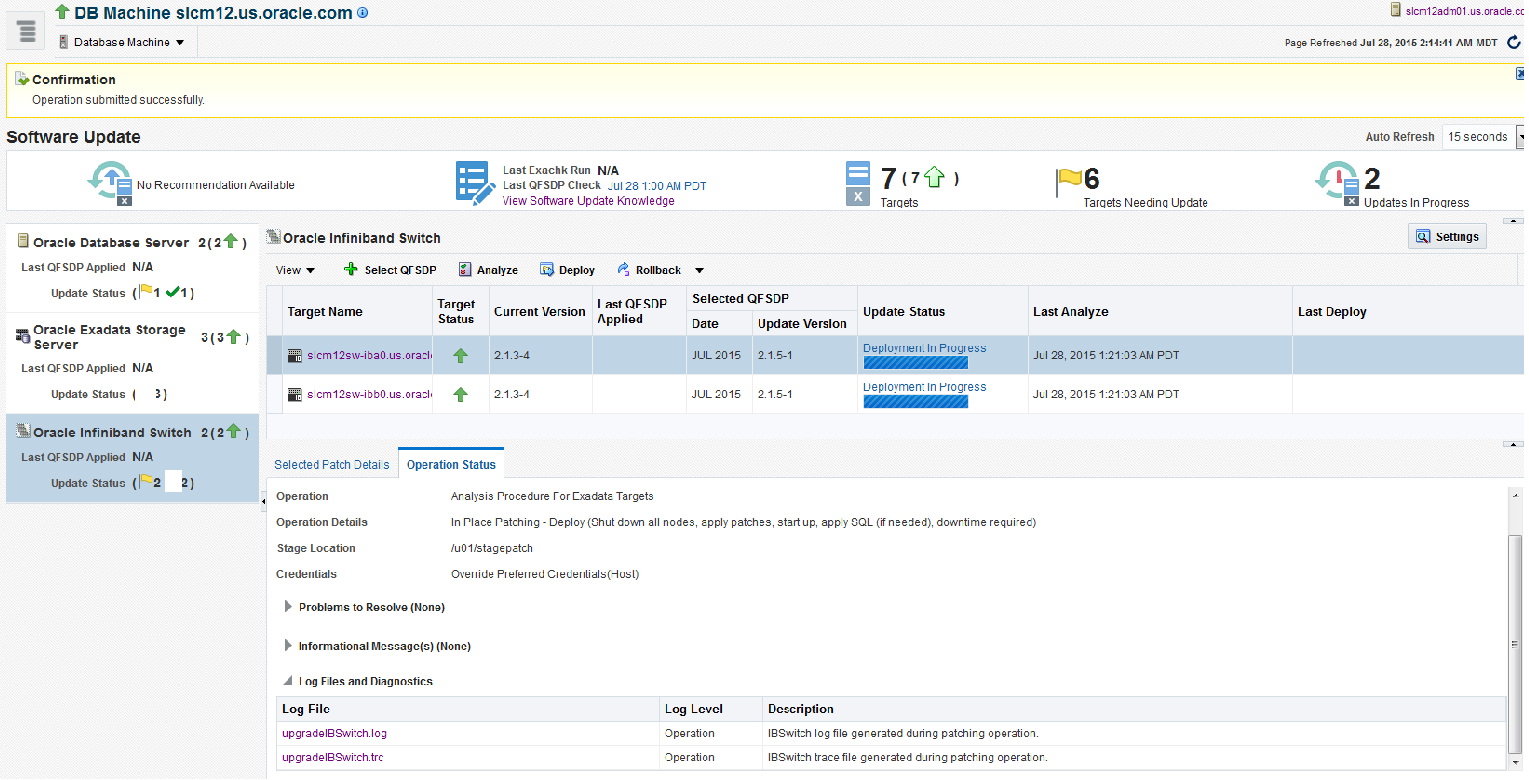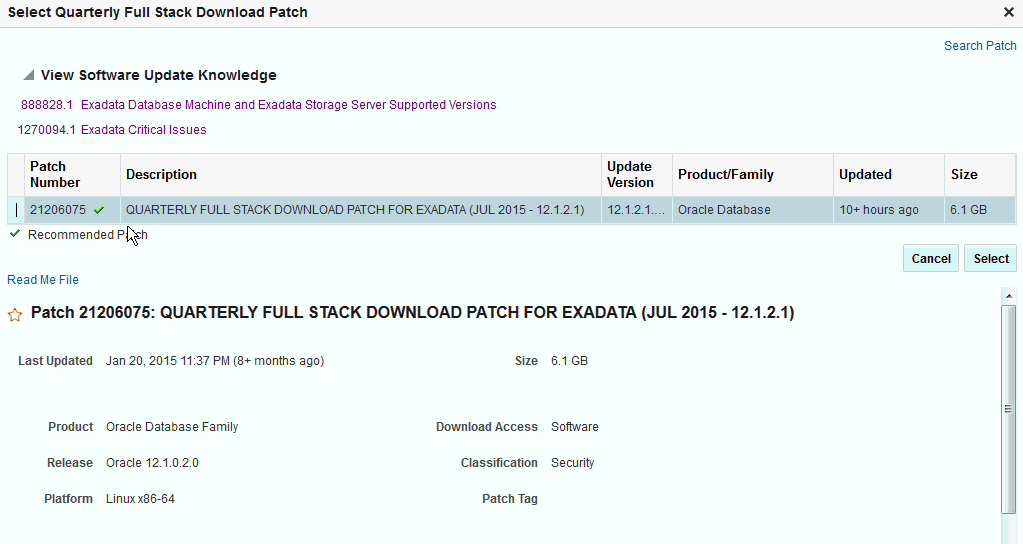46 Performing Engineered System Software Updates
46.1 Overview of Exadata System Software Update
Using Quarterly Full Stack Download Patches (QFSDP), you can update each component of an Exadata target, individually, independent of the other Exadata target components. Also, you can apply a different QFSDP on each Exadata target component. This approach minimizes downtime, as you can update a few Exadata component targets at a time, keeping the other components up and running. You need not update all the Exadata target components at once.
To update Exadata target components, you must use the Exadata Target Maintenance page. To access the Exadata Target Maintenance page, from the Targets menu, select Exadata. Click the Exadata target that you want to update. On the Exadata target home page, from the Database Machine menu, select Software Update.

Table 46-1 Exadata Update Information
| Parameter Name | Description |
|---|---|
|
Recommended QFSDP |
The patch recommendation feature for Exadata can function in two different modes: Online Mode and Offline Mode. In the Online Mode, the Download System Patch & Evaluate Patch Recommendations Job downloads the QFSDPs from the support site, and evaluates the Patch Recommendations. In the Offline Mode, you must upload the QFSDP to Software Library using EMCLI, following which, the Download System Patch & Evaluate Patch Recommendations Job checks for patches in the Software Library, and evaluate the Patch Recommendations for discovered Engineered System Targets. The Recommended QFSDP section provides a link to the readme of the patch, and the timestamp of the actual patch download. |
|
Last QFSDP Check |
The QFSDP check happens at an interval of 24 hours. The time when the last check happened is recorded in this section. |
|
Targets |
All the targets configured on the Exadata system and their status is recorded in this section. |
|
Targets Needing Updates |
The targets that are part of the system but are not at the latest patch level are the ones that need to be patched. The information about the number of targets that must be patched to bring them upto the recommended patch level is available here. |
|
Updates in Progress |
When you deploy or rollback a patch, the deployment procedure is submitted and the updates are said to be in progress. The number of targets that are involved in the update process is mentioned here. |
|
Components |
The Software Update page enables you to update the following components of the Exadata targets:
For any of the selected targets, you can view the following details:
|
Table 46-2 Update Status
| Status | Description |
|---|---|
|
|
This symbol implies that the selected target(s) of the components require updates to bring them to the recommended patch level. |
|
|
This symbol implies that the patch is currently being deployed, and the procedure is in progress. If it is successful, then a tick mark will appear, if not you will see a cross mark against the respective targets. |
|
|
This symbol implies that the selected target of the component is up-to-date with the latest patch. |
|
|
This symbol implies that patching failed, and that the patch could not be applied on the designated targets. |
For a selected component, in addition to details like the target name, status, version, update status, and when the last analyze and deploy happened, you have the following details:
-
Selected Patch Details: Details like the bug fixed and knowledge articles related the update are displayed here.
-
Operation Status: Information of the current operation on the targets is available in this section. For more granular details, select the Operation Tab to view the:
-
Summary: All the information that you have entered is available in the summary section. After the Analyze step completes, you can view the patching steps. Click Download to download and view the Oplan-based steps that are generated.
-
Problems to Resolve: Any issue encountered during analysis and deploy phase is recorded in this section.
-
Information Messages: This section contains the information text.
-
Log Files and Diagnostics: When the Analyze, Deploy, or Rollback phase is in progress, a list of static links are displayed. Click on the link to fetch the on-demand files and view the details of the log files and trace files that contain information about the patching steps performed on the targets.
After the patching process is complete, the log files are automatically fetched and stored in the OMS Repository. Click the link to download the zip file. The zip contains log and trace files that contain information about the patching steps are performed on the targets.
-
46.2 Configuring Options for Exadata Component Software Updates
Before patching an Oracle Exadata target component, you can choose to set up the options for patching, such that the options are reused for subsequent patching of targets within the same component present in the same Exadata system. Setting up the patch options enables you to proceed with the analysis phase of a subsequent Exadata target component patching operation without having to re-enter the options.
To set up the update options for a particular Exadata component, follow these steps:
46.3 Updating Exadata Database Servers
To patch the Exadata Database Server or Compute Node Server components of an Exadata target, follow these steps:
46.4 Updating Exadata Storage Servers
To patch the Oracle Exadata Storage Server components of an Exadata target, follow these steps:
46.5 Updating Exadata Infiniband Switches
To patch the Oracle Infiniband Switch components of an Exadata target, follow these steps:
Note:
The Exadata Infiniband Switches supports only component-based update.You cannot update individual targets.
46.6 Rolling Backup Deployed Software Updates
To rollback a Quarterly Full Stack Download Patch (QFSDP) that is deployed on an Oracle Exadata component, follow these steps:
Note:
You can not select the patch you want to rollback, instead, you can only rollback the latest QFSDP applied using Cloud Control.
46.7 Patching Oracle Identity Management Targets
Using patch plans, you can patch those Oracle Access Management Server and Oracle Identity Management Server targets that were provisioned using Identity Management Lifecycle tools. Other Oracle Identity Management targets are not supported for patching.
To patch Oracle Access Management Server and Oracle Identity Management Server targets (that were provisioned using Identity Management Lifecycle tools) using patch plans, you must have an Identity Management Pack Plus license. Also, the 12.1.0.6 Enterprise Manager for Oracle Fusion Middleware plug-in (or higher) must be deployed on the OMS, and on all the Management Agents running on the hosts on which the Oracle Access Management Server and Oracle Identity Management Server targets are deployed.
To patch Oracle Access Management Server and Oracle Identity Management Server targets using a patch plan, follow these steps:
46.8 Overview of Exalytics System Software Update
Enterprise Manager Cloud Control 13c enables you to apply Patch Set Updates (PSU) on Exalytics targets. Using PSUs, you can patch an Exalytics target component individually, independent of the other Exalytics target components. Also, you can apply a different Patch Set Update (PSU) on each Exalytics target component. This approach' minimizes downtime, as you can patch a few Exalytics target components at a time, while keeping the other components up and running.
For example, you can apply a particular Patch Set Updates on two compute nodes of an Exalytics target at a particular point in time, and apply a different PSUs on two other compute nodes of the Exalytics target one hour later. You need not patch all the compute nodes of an Exalytics target at once.
To patch Exalytics target components, you must use the Exalytics Patching page. To access the Exalytics Patching page, from the Targets menu, select Exalytics. Click the Exalytics target that you want to patch. On the Exalytics target home page, from the Exalytics System menu, select Patching.
46.9 Configuring the Options for Oracle Exalytics Updates
Before patching an Oracle Exalytics target component, you can choose to set up the options for patching, such that the options are reused for subsequent patching operations. Setting up the patch options beforehand enables you to proceed with the analysis phase of a subsequent Oracle Exalytics patching operation without having to re-enter the options.
To set up the options for an Oracle Exalytics patching operation, follow these steps:
46.10 Updating Oracle Exalytics Compute Nodes
To patch the compute nodes of an Oracle Exalytics target, follow these steps:
Note:
When you deploy a Patch Set Update (PSU) on an Oracle Exalytics compute node, the Oracle Integrated Lights Out Manager (ILOM) firmware installed on the compute node is also patched by default. You do not need to patch the ILOM firmware separately.
46.11 Updating Oracle Exalytics Business Intelligence Instance
To patch the BI Instance of an Oracle Exalytics target, follow these steps:
Note:
When you deploy a Patch Set Update (PSU) on an Oracle Exalytics compute node, the Oracle Integrated Lights Out Manager (ILOM) firmware installed on the compute node is also patched by default. You do not need to patch the ILOM firmware separately.
